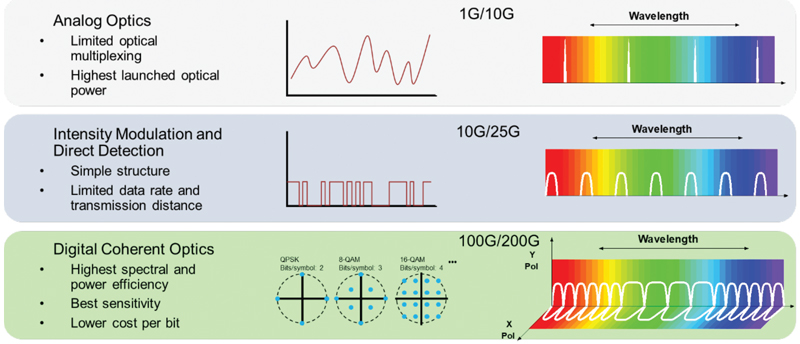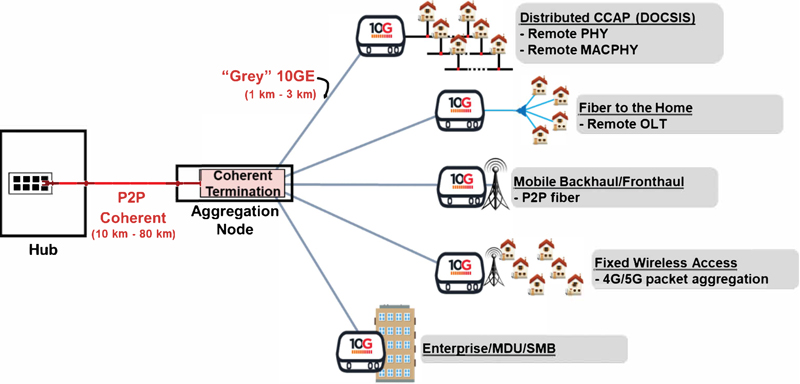Optics in Access
By Dr. Curtis Knittle
Fiber optic technology has long been a key component in communication networks, especially so with the hybrid fiber/coax (HFC) networks deployed by cable operators. From the earliest days of HFC networks, fiber was recognized as the most suitable communication media to extend the reach of radio frequency (RF) signals from the headend to distant homes (aka subscribers). In traditional HFC networks, RF signals exit the hub site as an optical signal, traveling over a fiber optic cable which terminates in a fiber node. The transmitted optical signal is one in which the intensity of the optical signal varies according to the current level of the electrical RF signal. In this sense, the electrical RF signal amplitude-modulates the laser to generate the optical signal. This is also referred to as analog modulation, or analog optics. The fiber node essentially performs a media conversion, converting the optical signal back to an electrical RF signal for final transmission over coaxial cable to the home, and vice-versa for the return signal. To extend the reach of the RF signal, there may be a series of amplifiers cascaded along the mainline coaxial cable, each one boosting the RF signal for homes farther from the fiber node. This network architecture has served the cable industry well for decades, proving to be both resilient and extensible, evolving to support higher capacities for highspeed data services (e.g., Internet services).
Don’t be fooled by the name into thinking with HFC networks there are equal parts fiber and coax; on the contrary, HFC networks are mostly fiber optics. In fact, HFC networks overwhelmingly leverage the superior distance and capacity fiber brings to this network solution. In North America it is not uncommon to find hub-to-node fiber lengths of 30 km, 40 km, or even greater. Many of these short optical link distances can be addressed without optical amplification. Erbium doped fiber amplifiers (EDFAs) can be used on longer 1550 nm links. When one considers that the coaxial portion of HFC networks is only 1 km or 2 km, fiber comprises upwards of 95% of link between the hub site and the subscriber home.
Increasing capacity on fiber strands
The significant lengths of fiber cables installed in cable networks are the result of billions of dollars of investment by cable operators, so naturally operators want to leverage the installed fiber base as much as possible. The popularity in fiber-connectivity transmission has generated fiber-strand shortages in high-demand areas. Furthermore, to meet the high carrier-to-noise ratio (CNR) and stringent fiber nonlinearity distortion tolerance of analog optics, the number of optical analog carriers is very limited in the fiber, thus the overall delivered capacity is reduced. Therefore, there are several ways that have been developed to increase the carrying capacity of installed fiber cables.
Wavelength division multiplexing
One method for increasing the capacity of installed fiber links is to use wavelength division multiplexing (WDM). With WDM, multiple optical signals, each at a different wavelength, are combined and transmitted over an optical fiber. At the terminating point, the wavelengths are separated, and the optical signal is demodulated to recover the original signal. In this method each wavelength metaphorically serves as a lane, much like highways are expanded by adding more lanes. WDM not only serves to increase capacity on an optical fiber, but it is also used to support bidirectional communication over a single fiber strand. The International Telecommunications Union (ITU) is the entity which defines the wavelengths and channel spacing for WDM transmission over a single fiber.
Transitioning from analog optics to digital optics
Another method for increasing the capacity of fiber links is to improve the way the fiber optical spectrum is used. In essence, leveraging digital communication theory by increasing the number of bits per second per hertz in the optical spectrum, the overall capacity of the fiber link is increased. In the early days of fiber transmission, at least for digital transmission, a simple method was used to represent each bit. Very simply, a laser was turned on to represent a ‘1’ bit, and the laser was turned off to represent a ‘0’ bit. For each bit interval, also referred to as the symbol interval in this particular case, the laser was either on or off. A relatively simple receiver directly detects the presence or absence of light to convert the light into an electrical signal for further processing. The number of symbol intervals per second, also known as the “baud,” multiplied by the number of bits per symbol, determines the number of bits per second being transmitted. In this simple case, the number of bits per second equals the baud since only one bit per symbol is transmitted.
Another form of digital optical communication is known as digital coherent optics. Not surprisingly, with increased complexity in the transmitter and receiver, capacity can be increased even further. The specific details of coherent modulation and detection are beyond the scope of this article, but suffice it to say that digital coherent optics increases the bits per symbol from one in the previous example to four, or eight, or 16. Combined with two optical polarizations and an increase in baud, digital coherent optics increases the carrying capacity of a single wavelength by orders of magnitude. For example, the simple intensity-modulation with direct detect (IM-DD) technology is capable of 25 gigabits per second (Gbps) on a single wavelength, while the digital coherent modulation is capable of 100 Gbps, 200 Gbps, 400 Gbps, and higher, and with a much greater number of wavelengths over the same fiber transmission window compared to analog optics.

Figure 1. Analog optics versus IM-DD versus digital coherent optics.
Cable network evolution
Why is this important for the cable industry? Because the cable industry is evolving their networks to support higher capacities and more intelligent edge devices, collectively known as the distributed access architecture (DAA). The DAA is characterized by using digital optics (and Ethernet) to carry the capacity provided by remote PHY or remote MACPHY devices, or even remote OLTs, mobile, and business. DAA is the foundation on which the 10G Platform (https://www.10gplatform.com/) is built.
One can see from Figure 2 the increased importance of the fiber link between hub site and fiber node. In this diagram, that particular link is referred to as a point-to-point link, which terminates at an electrically powered device known as the coherent termination device, a device mounted either in a cabinet or node.

Figure 2. The distributed access architecture.
Equally important will be defining coherent solutions in a point-to-multipoint topology, known as coherent passive optical networking (CPON), in which case the active component is replaced with a completely passive optical splitter/combiner.
Whether used in a point-to-point or point-to-multipoint topology, the few fibers comprising the fiber optic cable between hub and node will be required to “backhaul” significantly higher amounts of data since each of the DAA edge devices will be capable of delivering 10G services to subscribers. This is where digital coherent optical modulation plays a huge role. With single wavelength capacities in excess of 100 Gbps, coherent transceivers offer the right capabilities to carry the cable industry far into the future.

Dr. Curtis Knittle,
Vice President of Wired Technologies,
CableLabs
Dr. Curtis Knittle is the Vice President of Wired Technologies at CableLabs, the non-profit research & development lab funded by the global cable industry. Curtis and his team are responsible for specifying scalable deployment solutions in both hybrid fiber/coax and all-fiber access networks for CableLabs’ member companies. DOCSIS® technologies, full duplex DOCSIS, distributed CCAP architectures, and point-to-point coherent optics are a few current high priority projects under his leadership.



